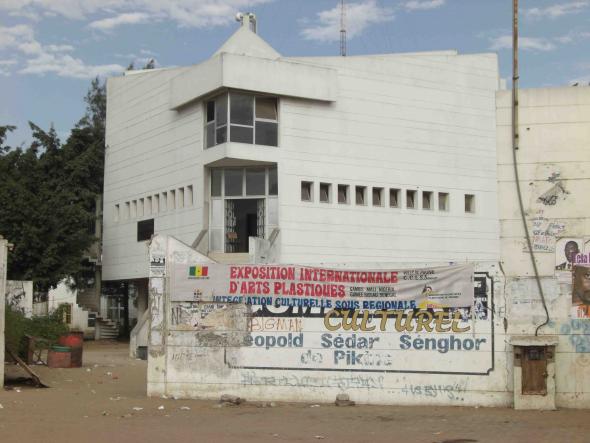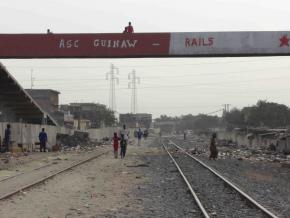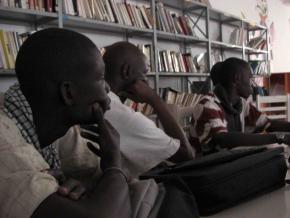Dakar's Cine-suburb: Young people create a cine-club in Pikine.
Dakar became overpopulated towards the beginning of the fifties. A displacement of families away from the inner city neighbourhoods was decided by the colonial state: they were truly “evictions” framed within urban planning projects. The Pikine department was created, regrouping “all of Dakar’s excluded”. Today it accounts for about one million persons: there is talk about “Pikine-Peking”.
 Cine-clube Pikine
Cine-clube Pikine
Pikine faces serious sanitation issues due to the lack of plumbing used in rain and dirty water evacuation. Water infiltrates houses to the point where families eat, sleep and live with their feet under water for several months. During last winter some families were forced to temporarily move to shelter tents, returning home only in the dry seasons. Certain homes were in fact abandoned: water had invaded the corridors, turning them into pools covered with green algae, with all the obvious public health problems.
Along Pikine’s vicinity other places house thousands of persons: Tounde Ndargou, Dalifor, Hann-Montagne, Dagoudane Pikine, Guinaw-Rails and Thiaroye-sur-mer. The village of Thiaroye is still known for a massacre that happened during the 40-45 war, the “Senegalese shooters” (about 1300 african soldiers) had demanded their grants and demobilization prizes. In 1944 the french army assaulted the Thiaroye Camp. The survivors were sentenced to death./p>
Thiaroye Camp, where Ousmane Sembene shot the film bearing the same name, became a market since 2000. Young people complain: “we wanted to preserve our history” they say.


In Guinaw-Rails (meaning “behind the railway”), the population is forced to move daily trough creeks of used water, the pumping station isn’t powerfull enough and only works in the rainy season. The population is helpful and manually evacuates the water with shovels, plastic hoses and a motor pump they all bought together. The “law of making by» is the rule and a matter of survival.
Using cinema to make your voice heard: Séni
The suburbs are par excellence the shooting location of the young people involved in Cine-suburb. Séni tells the story a “terrible student”, Séni Fall, who grew up up in the “ghetto”. Having finished college’s second year he was faced with precarity: he had no more money to enroll. So, he says, “the streets get you back and set your way”. His life story is equal to that of most young people in Pikine. Séni talks about marginality and the search of identity in a society where everything is a struggle for survival.
It’s the first collaborative effort of cine-suburb, an association born out of the passion for film of young amateurs, an “unemployed youth on the verge of a teapot”. It’s a cinema ripe with resistance and revolt.
In 2007, Khouma directed his first documentary about the floods – Entropia – with the help of a 3 CCD camcorder, lent by the french association Jonathan, there to teach young people information technology basics. “I’ve learnt that you didn’t have to have a camera to make a movie. You have to think before you shoot.”
Khouma was amongst the first involved in cine-suburb to leave his neighbourhood to go to film projections in Dakar’s downtown. “They thought we were crazy, going downtown to watch films at the French Cultural Center or the Goethe institute, when they show films on TV!”
After some time they decided to challenge the city’s monopoly. Ticket prices and distance to the capital’s few screening rooms moved Khouma and Demba to try and take the cinema…to the suburbs. A german acquaintance provided for the first projection. “The day he came to visit us in Pikine people started to believe in us”.

A story of passion
Cine-suburb is also born due to the militant passion of Professor Abdel Aziz Boye, director and teacher at the Polytechnic Superior School of Dakar’s Cheick Anta Diop University. It was born in his office, amidst passionate arguments about cinema. The university authorities know about the project, “but don’t truly believe in it”, he says.
In 2008 a film introduction course took place in Guédiawaye, at the local sociocultural center. The people came from the vicinity: Guédiawaye, Guinaw-Rails, Keur Massar, Mbao. The word of mouth spreading among the youth was “there’s an utopian called M. Boye teaching cinema!”
Since last year, Cine-suburb moved to the Pikine’s Léopold Sédar Senghor Cultural Complex. On the screens they show, for now, only senegalese cinema: among others: Sembene Ousmane and Djibril Diop Mambéty.
In Cine-suburb everything is done informally, in a improvised room, since the most important is discussion, reflection and discovery. «We can only count on us” says the teacher. A quota system was introduced: solidarity, sharing and exchange make the cineclub’s survival possible.
For now the films are scarce and the public has yet to come. It’s a place for work and research. Everyone develops his project and shares it with others under professor Boyle’s direction.
The cineclub will organize a big projection of Séni for the first time on 13th february 2010, with the presence of local authorities. Through the voice of moving image young people are making heard their intentions: to have a say about their daily life, their struggle and their dreams.
Films in the process of writing:
- Nouyo Mouride, de Mouhamed Siradji Sow
- Le Messager de la Foi, de Moussa Fall
- Le Poète errant, de Cheick Ahmadou Bamba Diop
- Sous la fenêtre de Grand Makhaly, de Pape Lopy
- Murmure, de Charles Seck
- Naal, de Mamadou Khouma Gueye
- Un monde différent, de Ngima Badji
Films in the process of editing:
- El Fenomeno (Le Lutteur), de Demba Dia
- Mbedmi (La Rue), de El Hadji Babacar Diallo
- Du husteling à l’entertainement, de Mamadou Khouma Gueye, Makhfouse Diop et Demba Dia
Directed films:
- Entropie a Guinaw-Rails de Mamadou Khouma Gueye
- Daouda, Sounay, Saly de Kady Diedhiou
- GR 89/09, de Makhfouse Diop et Mamadou Khouma Gueye
- Séni, de Mamadou Khouma Gueye